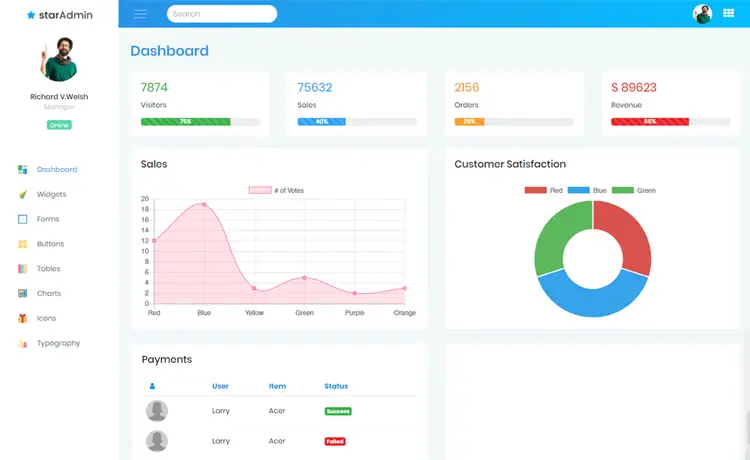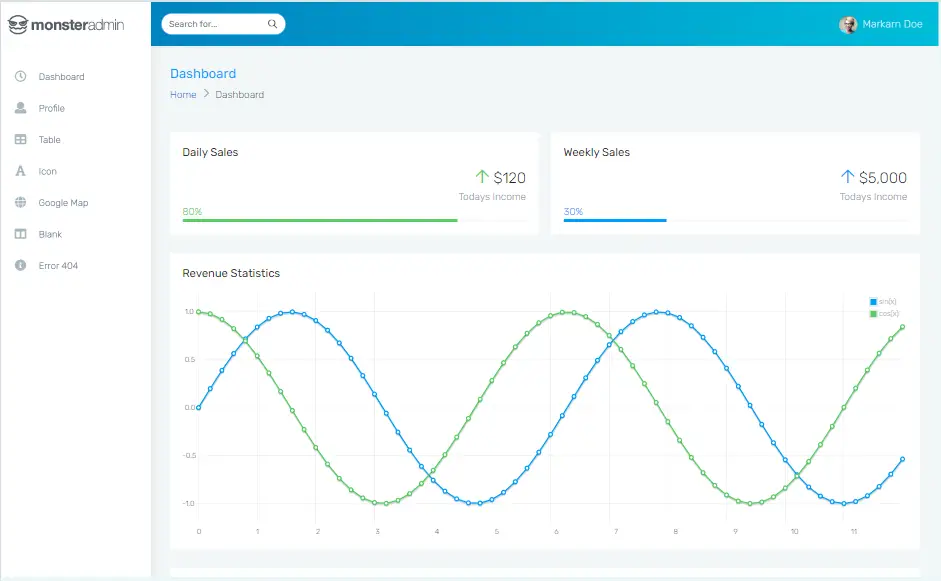How to Create an exception handler in ASP.NET Core 8
By Tan Lee Published on Mar 08, 2020 572
The article explains how to leverage IExceptionHandler to provide users with meaningful error responses, enhancing the overall error-handling experience in ASP.NET Core 8 applications.
Understanding the Need for an Exception Handler
In ASP.NET Core, an exception handler is a component that manages unhandled exceptions globally, providing a centralized mechanism for error handling. It ensures that exceptions are caught, errors are logged and processed, and meaningful error responses are generated, allowing the application to fail gracefully.
using Microsoft.AspNetCore.Diagnostics;
using Microsoft.AspNetCore.Mvc;
using System.ComponentModel.DataAnnotations;
using System.Net;
var builder = WebApplication.CreateBuilder(args);
var app = builder.Build();
app.UseExceptionHandler(option => { });
app.MapGet("/GenerateError", () =>
{
throw new NotImplementedException();
});
app.Run();When accessing the /GenerateError endpoint, the error response displayed in the browser is unformatted, making it difficult to read and understand the error metadata.
Introducing the IExceptionHandler interface
ASP.NET Core 8 enhances this with the introduction of the IExceptionHandler interface, allowing developers to create a centralized class for handling exceptions in their applications.
public interface IExceptionHandler
{
ValueTask<bool> TryHandleAsync(HttpContext httpContext, Exception exception, CancellationToken cancellationToken);
}The IExceptionHandler interface includes the TryHandleAsync method, which takes three parameters: HttpContext, Exception, and CancellationToken, and returns a ValueTask to indicate whether the exception was handled. When implementing this method, you must return true if the exception is handled, or false if not.
How to Create a custom exception handler in ASP.NET Core
To implement the IExceptionHandler interface, create a class called GlobalExceptionHandler in a file named GlobalExceptionHandler.cs and add the appropriate code to it.
public class GlobalExceptionHandler(IHostEnvironment hostEnvironment, ILogger<GlobalExceptionHandler> logger)
: IExceptionHandler
{
public async ValueTask<bool> TryHandleAsync(HttpContext httpContext, Exception exception, CancellationToken cancellationToken)
{
return true;
}
}Your custom error handling logic should be placed in the TryHandleAsync method, where you can handle exceptions asynchronously, as shown in the following code snippet.
private const string ExceptionMessage = "An unhandled exception has occurred while executing the request.";
public async ValueTask TryHandleAsync(HttpContext httpContext, Exception exception, CancellationToken cancellationToken)
{
logger.LogError(exception, exception is Exception ? exception.Message : ExceptionMessage);
var problemDetails = CreateProblemDetails(httpContext, exception);
await httpContext.Response.WriteAsJsonAsync(problemDetails, cancellationToken);
return true;
}The CreateProblemDetails method creates a ProblemDetails object containing error metadata, as shown below:
private ProblemDetails CreateProblemDetails(HttpContext httpContext, Exception exception)
{
httpContext.Response.ContentType = "application/json";
// Determine the appropriate HTTP status code based on the exception type
switch (exception)
{
case UnauthorizedAccessException unauthorizedAccessException:
httpContext.Response.StatusCode = (int)HttpStatusCode.Unauthorized;
break;
case ArgumentNullException argumentNullException:
httpContext.Response.StatusCode = (int)HttpStatusCode.BadRequest;
break;
default:
httpContext.Response.StatusCode = (int)HttpStatusCode.InternalServerError;
break;
}
// Create a ProblemDetails object with error metadata
return new ProblemDetails
{
Status = httpContext.Response.StatusCode,
Type = exception.GetType().Name,
Title = "An error occurred processing your request",
Detail = exception.Message,
Instance = $"{httpContext.Request.Method} {httpContext.Request.Path}"
};
}Full Source Code for Custom Exception Handler
The following code provides the complete source code for the GlobalExceptionHandler class.
public class GlobalExceptionHandler : IExceptionHandler
{
private const string ExceptionMessage = "An unhandled exception has occurred while executing the request.";
private readonly ILogger<GlobalExceptionHandler> _logger;
public GlobalExceptionHandler(IHostEnvironment hostEnvironment, ILogger<GlobalExceptionHandler> logger)
{
_logger = logger;
}
public async ValueTask TryHandleAsync(HttpContext httpContext, Exception exception, CancellationToken cancellationToken)
{
// Log the exception
_logger.LogError(exception, exception.Message);
// Create the problem details response
var problemDetails = CreateProblemDetails(httpContext, exception);
// Write the response as JSON
await httpContext.Response.WriteAsJsonAsync(problemDetails, cancellationToken);
return true;
}
private ProblemDetails CreateProblemDetails(HttpContext httpContext, Exception exception)
{
httpContext.Response.ContentType = "application/json";
// Set status code based on exception type
httpContext.Response.StatusCode = exception switch
{
NotImplementedException => (int)HttpStatusCode.BadRequest,
_ => (int)HttpStatusCode.InternalServerError
};
// Return structured problem details
return new ProblemDetails
{
Status = httpContext.Response.StatusCode,
Type = exception.GetType().Name,
Title = "An unexpected error occurred",
Detail = exception.Message,
Instance = $"{httpContext.Request.Method} {httpContext.Request.Path}"
};
}
}Registering the Exception Handler in the Pipeline
To use the custom exception handler in your application, register it in the request processing pipeline by adding builder.Services.AddExceptionHandler<GlobalExceptionHandler>(); in the Program.cs file.
Then, create an error-handling endpoint using app.MapGet("/GenerateError", () => { throw new ValidationException(); }); to simulate an error.
Next, configure the pipeline to use the exception handler with app.UseExceptionHandler(opt => { });. When accessing the /GenerateError endpoint, the application will display a user-friendly error response, as defined by your custom handler.
For example:
builder.Services.AddExceptionHandler<GlobalExceptionHandler>();
app.MapGet("/GenerateError", () =>
{
throw new ValidationException();
});
app.UseExceptionHandler(option => { });Implementing a custom exception handler ensures that error responses meet your specific format and requirements, giving you more control over how exceptions are managed in your application.
- Implement security headers for an ASP.NET Core
- How to add security headers to an ASP.NET Core Application
- How to Initialize TagHelpers in ASP.NET Core with Shared Data
- Boost Your ASP.NET Core Website Performance with .NET Profiler
- The name 'Session' does not exist in the current context
- Implementing Two-Factor Authentication with Google Authenticator in ASP.NET Core
- How to securely reverse-proxy ASP.NET Core
- How to Retrieve Client IP in ASP.NET Core Behind a Reverse Proxy





